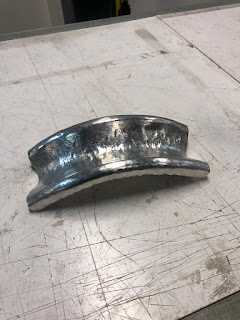Project 2: Reverse Curve
Introduction
This is the second project for BEIL0014 for making a torus which is referred as a reverse curve in meal shaping, the following shows the procedures.
Procedure
Starting with a sheet of aluminium, same as before, crafting tool is used to mark the sheet with calculated parameters. The measured width of the sheet metal is 11.85cm which I take it as 12cm for easier calculations. The sheet of 12 cm width is being divide into three section.
The left and right section with 3.5cm each reserved for constructing two peaks of the curve and the core (middle) section reserved for constructing the trough of the curve.
After that, middle lines are drawn in the middle of each section, so that there are five lines in total.
Next, the sheet is being pressed on a wooden cylinder, which creates the primary curve for the reverse curve. The wooden cylinder contain a sloped curve in the middle. Gradually bit by bit, I hammer in the middle of the sheet on the middle section only, this procedure is cooperated with another student with one held the wood with sheet sticking to the curvature of it firmly and another one hammer the middle section of the sheet to create trough/ secondary curve of the reverse curve.
The shape of the reverse curve has been created.
Next, the thin curve shaped tool is being used to help create the peaks of the reverse curve. Using the line which I drawn previously, I was able to precisely hammer the 2 identical peaks from the left and right section of the sheet. This step is also cooperating with another student with one holding the sheet metal and another one swinging the finishing hammer. Finishing hammer is chosen for this job is because it is flat on the contact surface which is perfect if the sheet metal is supported with desire shape.
This photo shows the before hammering alignment to the curve shaped tool on the right section.
This is after hammering.
This process is repeated on the left section of the reverse curve as well. After that, thinner curved tool is being used for more precised work.
The curve from the reverse curve is matching the curved tool.
































